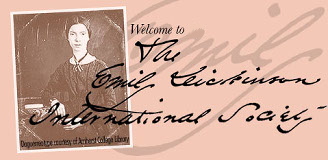
You are hereDurkin, Katelyn: "To Fragment: Emily Dickinson’s Poetics of Process and Nineteenth-Century Print Culture"
Submitted by RFranz on July 19, 2013 - 10:15am
To Fragment: Emily Dickinson’s Poetics of Process and Nineteenth-Century Print CultureKatelyn Durkin, University of Virginia Emily Dickinson’s material practice of binding her poems into fascicles has often been named a mode of “private publication.” Martha Nell Smith identifies this material production as constitutive of the poet’s highly sensual writing-reading relationship with Susan Huntington Gilbert Dickinson, and Betsy Erkilla reads it as a marker of the class privilege that allowed Dickinson to eschew traditional print publication. While both Smith’s and Erkilla’s works reinstate Dickinson within her sociohistorical moment by examining the poet’s attitudes toward other people, their descriptions of her “private publication” risk decontextualizing her writing from nineteenth-century print culture: Smith names the fascicle binding a “cottage-industry literary production,” while Erkilla notes that Dickinson “appears to have engaged in a kind of home or cottage industry, a precapitalist mode of manuscript production and circulation.” These images of domestic publication are useful for underscoring the difference between Dickinson’s material practices and the contemporary publishing industry, but obscure this difference’s potential foundation in the poet’s interaction with, not isolation from, print culture. By examining Dickinson’s fragments – her drafts, notes, and word variants written on scraps of paper that juxtapose her writing with printed text – I demonstrate how Dickinson engaged with contemporary notions of the “poet” through material texts in order to establish her unconventional poetics of process. By tearing, folding, and writing over printed materials such as magazines and concert programs, Dickinson created new borders as she destroyed old ones, generating heteroglossic texts that figure the tensions between her poetry and these objectified publications. I particularly examine her use of printed materials that stage the poet’s conventional roles as student and performer to show how Dickinson presented these relatively fixed and repetitive functions as negative examples for her own notion of the poet as one who engages in the fluid processes of creation and interpretation, not one who generates “products.” By examining Dickinson’s material practices beyond her fascicle binding and building on Marta Werner’s innovative work with the late fragments, I hope to position Dickinson as an artist in dialogic, fraught affiliation with her milieu and to restore our sense of the paradox inherent in the phrase “private publication.”
|